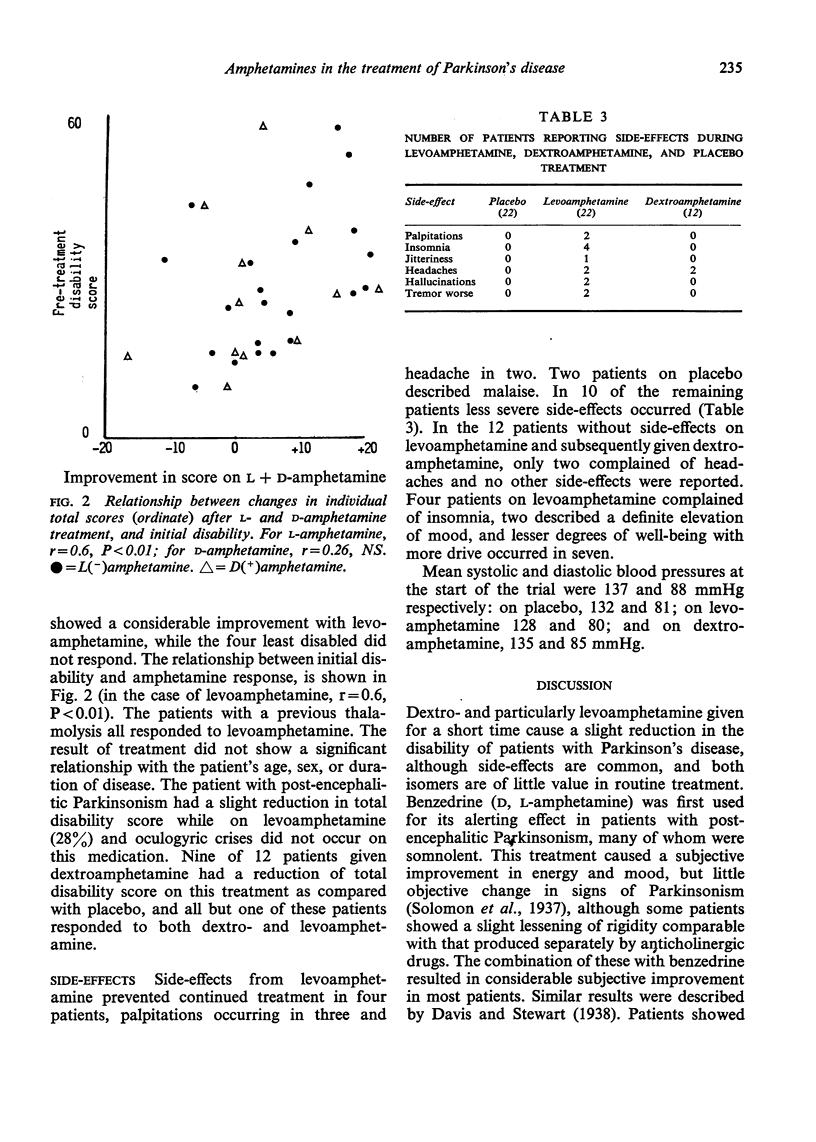Abstract
Twenty-two patients with Parkinsonism were treated with levoamphetamine and 12 of these with dextroamphetamine. Levoamphetamine resulted in a significant improvement in disability from Parkinsonism, although the reduction in total disability, tremor, akinesia, and rigidity scores was slight (ca 20 percent). Dextroamphetamine in lower dosage also reduced disability by some 17 percent. The most disabled patients, including those also on levodopa, showed the greatest response to amphetamines. Previously, amphetamines have been reported to be a selective treatment for the oculogyric crises of post-encephalitic Parkinsonism. Amphetamines are thought to cause the release of catecholamines from central neurones. Their action in Parkinson's disease may be limited because of pre-existing striatal dopamine deficiency. Side-effects of amphetamines, anorexia, and CNS stimulation are different from those caused by levodopa in patients with Parkinson's disease.
Full text
PDF





Selected References
These references are in PubMed. This may not be the complete list of references from this article.
- ASHCROFT G. W., ECCLESTON D., WADDELL J. L. RECOGNITION OF AMPHETAMINE ADDICTS. Br Med J. 1965 Jan 2;1(5426):57–57. doi: 10.1136/bmj.1.5426.57-b. [DOI] [PMC free article] [PubMed] [Google Scholar]
- Calne D. B., Reid J. L. Antiparkinsonian drugs: pharmacological and therapeutic aspects. Drugs. 1972;4(1):49–74. doi: 10.2165/00003495-197204010-00004. [DOI] [PubMed] [Google Scholar]
- Everett G. M., Borcherding J. W. L-dopa: effect on concentrations of dopamine, norepinephrine, and serotonin in brains of mice. Science. 1970 May 15;168(3933):849–850. doi: 10.1126/science.168.3933.849. [DOI] [PubMed] [Google Scholar]
- GLOWINSKI J., AXELROD J. EFFECT OF DRUGS ON THE UPTAKE, RELEASE, AND METABOLISM OF H3-NOREPINEPHRINE IN THE RAT BRAIN. J Pharmacol Exp Ther. 1965 Jul;149:43–49. [PubMed] [Google Scholar]
- HALLIDAY A. M., NATHAN P. W. Methyl phenidate in parkinsonism. Br Med J. 1961 Jun 10;1(5240):1652–1655. doi: 10.1136/bmj.1.5240.1652. [DOI] [PMC free article] [PubMed] [Google Scholar]
- Harris J. E., Baldessarini R. J. Uptake of (3H)-catecholamines by homogenates of rat corpus striatum and cerebral cortex: effects of amphetamine analogues. Neuropharmacology. 1973 Jul;12(7):669–679. doi: 10.1016/0028-3908(73)90120-2. [DOI] [PubMed] [Google Scholar]
- Marsden C. D., Barry P. E., Parkes J. D., Zilkha K. J. Treatment of Parkinson's disease with levodopa combined with L-alpha-methyldopahydrazine, an inhibitor of extracerebral DOPA decarboxylase. J Neurol Neurosurg Psychiatry. 1973 Feb;36(1):10–14. doi: 10.1136/jnnp.36.1.10. [DOI] [PMC free article] [PubMed] [Google Scholar]
- Mattson R. H., Calverley J. R. Dextroamphetamine-sulfate-induced dyskinesias. JAMA. 1968 Apr 29;204(5):400–402. [PubMed] [Google Scholar]
- Parkes J. D., Fenton G., Struthers G., Curzon G., Kantamaneni B. D., Buxton B. H., Record C. Narcolepsy and cataplexy. Clinical features, treatment and cerebrospinal fluid findings. Q J Med. 1974 Oct;43(172):525–536. [PubMed] [Google Scholar]
- Rylander G. Psychoses and the punding and choreiform syndromes in addiction to central stimulant drugs. Psychiatr Neurol Neurochir. 1972 May-Jun;75(3):203–212. [PubMed] [Google Scholar]
- STEIN L. SELF-STIMULATION OF THE BRAIN AND THE CENTRAL STIMULANT ACTION OF AMPHETAMINE. Fed Proc. 1964 Jul-Aug;23:836–850. [PubMed] [Google Scholar]
- Thornburg J. E., Moore K. E. Dopamine and norepinephrine uptake by rat brain synaptosomes: relative inhibitory potencies of 1- and d-amphetamine and amantadine. Res Commun Chem Pathol Pharmacol. 1973 Jan;5(1):81–89. [PubMed] [Google Scholar]


